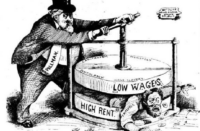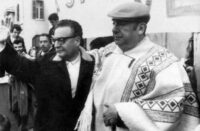The play Jimmy’s Hall, running at the Abbey Theatre, is said to be adapted from Paul Laverty’s film script of the same name, directed by Ken Loach.
When the film was first mooted it sent a scurry of excitement around certain sections of the left, and in particular the CPI, as Jimmy was one of our own and his story was well known to our members, past and present. Indeed one of the main people keeping the name and story alive is Cllr Declan Bree of Sligo, a former member of the Connolly Youth Movement.
So when Ken Loach produced his version we went along in anticipation that the real issues would not be dodged, and to a large extent we were not disappointed (though personally I was a little disappointed: the context was not fully explained; read on and it will become clear why).
So we now have a singing and dancing version. Alarm bells are ringing loudly in my head; worse, the previews and the Abbey’s own description of the play are back to the old narrative of “he just wanted people to dance and sing and be free.” Connolly wept!
After deciding I was not going to subject myself to this nonsense, a family member went and got me a ticket. So I had another look.
The cast were good: Bosco Hogan, Dónal O’Kelly, Lisa Lambe, Aindrias de Staic (of the “No Privatisation” song). At least the show will look and sound good. But I was still very sceptical about what the content would be.
Well, I have to say I was pleasantly surprised. Not only was the C word used but the context of it (it was early 1930s Ireland) and the events were exposed fully and in the right context.
Jimmy Gralton was a communist who had returned to his native Co. Leitrim after spending time in the United States. Not only did he bring back the latest jazz records and dance crazes but he also had a deep, burning passion for the new system being built in the Soviet Union, and was more than aware that fascism was on the rise in Europe. He taught the local youth and poor not only to dance and sing but to think for themselves, to identify their class needs and to act on them.
Needless to say, it didn’t take long for the Church in particular to notice; and here is where the play differs—for the better—from the film. The control the Church had over the government and its policies is laid out precisely, especially over de Valera, shown in the pressure they put on Dev to act, and the fact that they could get a crowd of over two thousand to burn down Connolly House during the Eucharistic Congress, luckily without the loss of life.
The play pulled no punches in showing how the link between the Blueshirts and the Church had the final say in Jimmy’s departure, and also in settling local land disputes (in favour of the landlords, of course). Altogether, the play described what was the expulsion of a very popular communist from Co. Leitrim and Ireland in a most unusual and unashamed way.
My fear that the producers would “dumb down” the facts of the case were unfounded—not that Loach’s film did either, but I can’t understand the clarity in one that is missing from the other, and with the same scriptwriter.
The play begins with some of the speech of Michael D at the unveiling of a marker on the site of the hall, and ends with an account of the laws passed after they got rid of Jimmy: no holding of dances in halls without a licence, and the fact that the Church then decided to set up parochial halls in every parish in Ireland and apply for the dancing licence. (So for all you old-timers out there who danced in a parochial hall, you have Jimmy Gralton to thank.)
I am not a regular theatregoer (as you may have guessed); but the acting, the dancing and above all the stage set were breathtaking and well worth the ticket price.





